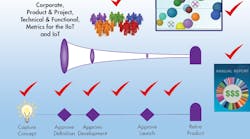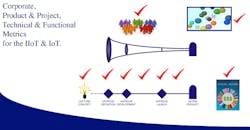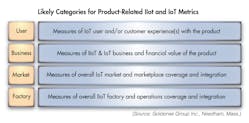Download this article as a .PDF
Every time there is an industry-wide adoption of a new capability or technology, metrics soon follow. Some 50-plus new metrics, which always lag the business initiatives in practice, are typically tried out by companies and analysts as they learn their way to success. People talk. Researchers research. Articles are written. Eventually, the cream rises to the top after a couple decades and five to 10 become frequently used.
Corporate-Level Metrics: Just as New Product Revenues (aka Vitality Index) swept across industry, and the IP wave added IP-Protected New Product Revenues, so too will IoT Revenues be measured as companies learn how to monetize the IoT capabilities they design into products. IoT-Related New Product and Total Revenues are a sure thing.
IP-Protected and Total IoT Revenues are also logically likely. Global competition to be one of the companies regarded as providing the best “soft value” to their customers and having the best big data analytics that can generate new “soft businesses” will be intense. The expected model is that everyone will eventually share data openly. It is likely to be a bit more Darwinistic. IP protection and data ownership are probably the rules of the road to for getting the most from the cloud and big data.
Project & Product Metrics: Although these two categories are absolutely distinct, it is best to handle them together as they occur concurrently. A project is a temporary organization vehicle used to develop products. At most companies, the project continues a tad after launch and then the product reverts to being measured with other company products such as Corporate-Level Metrics. Prior to launch, the product is the purpose of the project.
In “Metrics for IoT in the Product Development Process,” the focus was on project metrics. Here we will look at product metrics, no small subject. It won’t be just about the IoT. It will be equally about the IIoT, the Industrial Internet. Manufacturing managers will compete with marketing managers for real estate on the product and for subsequent product life-cycle big-data tracking capabilities.
There will be lights-out factories only if the product is fully integrated with the process. Similarly, there will be Best-in-Class IoT products only if they fully integrate with customers and users. Every sensor, processor, transmitter/receiver, and unit of storage adds product cost. Designers and testers are sure to end up in the middle of this real-estate problem. Perhaps this is a good place to look for metrics.
For example, the wearables industry is already calculating Sensors Per Product. In 2013, a typical wearable had 1.4 sensors. By 2019, there are expected to be 4.1 sensors per product—triple the 2013 amount. Generically, this metric is “Sensor Density.” Right now it is only measured with regard to the IoT. Many B2B and B2C companies will sub-divide this into IIoT-Sensor Density and IoT-Sensor Density as factories become increasingly automated and management also wants to track life-cycle performance and end-of-life compliance.
In the big picture, there will likely be four primary categories of product measures (see figure below). “Factory” metrics will measure capabilities relating to manufacturing and supplier performance. “Market” metrics will measure capabilities relating to a launched product out in the wilds of the marketplace. “Business” metrics will measure the contribution of the product to corporate results. “Customer/User” metrics will measure post-launch experience and satisfaction.
Functional & Technical Metrics: People design products. Without people, there are no products. A lights-out factory starts after people design the product and process. There will be more hiring and staffing metrics than when software entered the mechanical, electromechanical, and electronic industries: storage, big data, analytics, mathematics, a dozen more. There will be a slew of metrics relating to open innovation and the external sourcing of IoT solutions and “standard” industry platforms, along with related risk measures of externally required competencies. How about IIoT and IoT Black-Belt and SME certifications? IoT Competency Levels?
The leading edge of industry is already deploying some of these measurement approaches. In the “soft value era,” there will be many fewer reverse engineering and digitization tools for companies to use to catch up. The number of observation points available to examine and understand competitor offerings will be greatly diminished. It will be harder to calibrate and leapfrog. There will be a larger price to pay to be late to the table.



